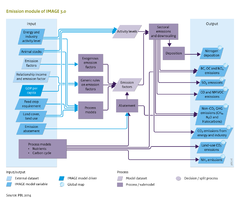Emissions/Description: Difference between revisions
Jump to navigation
Jump to search
No edit summary |
m (Text replace - "EDGAR model" to "EDGAR database") |
||
| Line 22: | Line 22: | ||
Emission factors (EFs) ([[equation 5.1]]) are used to estimate emissions from the various energy-related sources ([[Table 5.2]]). In general, the so-called Tier 1 approach from IPCC guidelines ([[IPCC, 2006]]) is used. In the energy system, emissions are calculated by multiplying energy use fluxes with time-dependent emission factors. Changes in the emission factors represent technological improvements and end of-pipe control techniques, fuel specification standards for transport, clean-coal technologies in industry, etc. | Emission factors (EFs) ([[equation 5.1]]) are used to estimate emissions from the various energy-related sources ([[Table 5.2]]). In general, the so-called Tier 1 approach from IPCC guidelines ([[IPCC, 2006]]) is used. In the energy system, emissions are calculated by multiplying energy use fluxes with time-dependent emission factors. Changes in the emission factors represent technological improvements and end of-pipe control techniques, fuel specification standards for transport, clean-coal technologies in industry, etc. | ||
The emission factors are calibrated for the historical period on the basis of the [[EDGAR | The emission factors are calibrated for the historical period on the basis of the [[EDGAR database|EDGAR emission model]] as described by [[Braspenning Radu et al., 2012]]. The calibration to the EDGAR database is not always straightforward due to differences in aggregation level. The general rule is to use weighted average emission factors in the case of aggregation. However, in those cases in which this results in incomprehensible emission factors (in particular when large differences exists between the emission factors for the underlying technologies) specific emission factors were chosen. | ||
==Future emission factors are based on different rules:== | ==Future emission factors are based on different rules:== | ||
Revision as of 15:03, 15 January 2014
Parts of Emissions/Description
| Component is implemented in: |
Components:and
|
| Projects/Applications |
| Models/Databases |
| Key publications |
| References |
|
